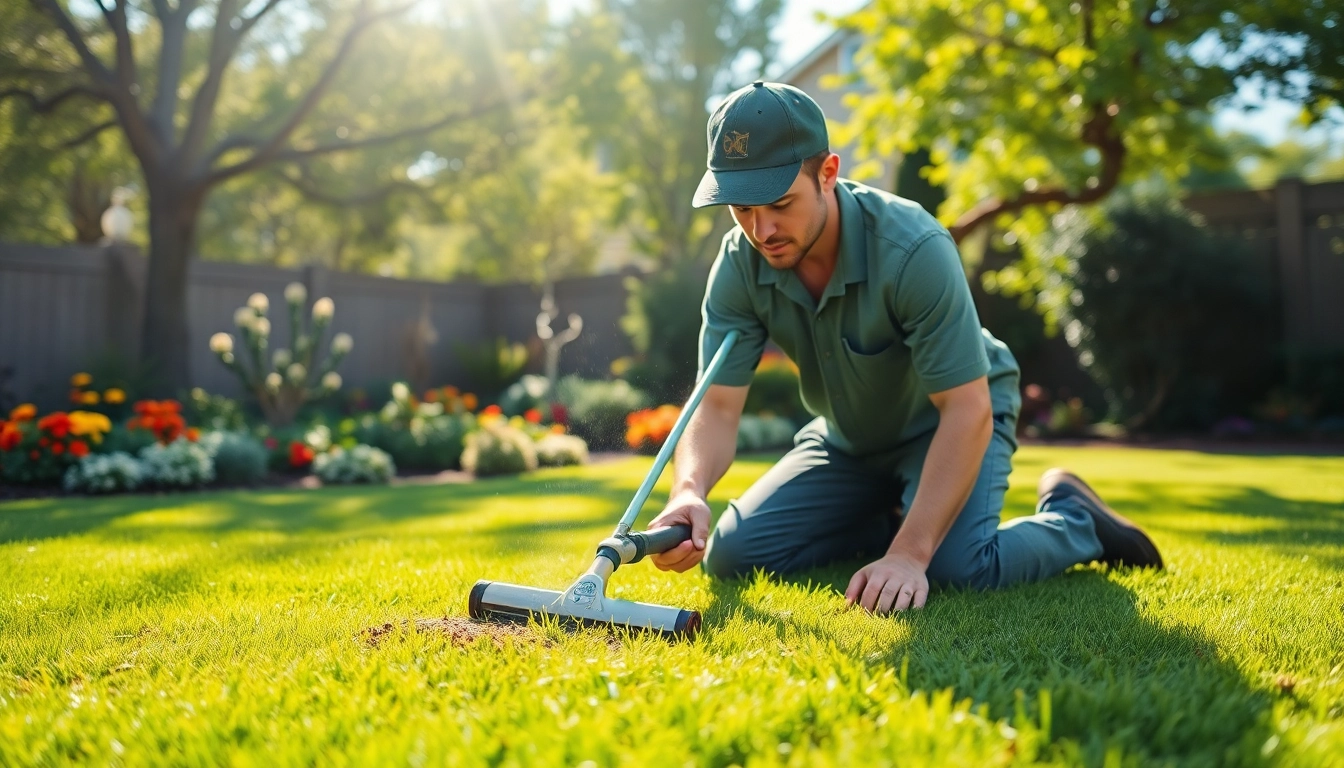Understanding Turf Cleaning
What is Turf Cleaning?
Turf cleaning refers to the comprehensive process of maintaining and rejuvenating grass surfaces, be it natural or synthetic turf. This process involves a series of methods aimed at removing debris, dirt, stains, and lawn pests that disrupt the aesthetic and health of your lawn. A clean, well-maintained turf not only enhances visual appeal but also promotes the longevity and health of the grass itself. With proper turf cleaning, your outdoor living space can become a pristine environment that encourages healthy growth and minimizes disease transmission.
Benefits of Turf Cleaning
Engaging in regular turf cleaning brings a multitude of benefits:
- Enhanced Aesthetics: A clean lawn significantly improves the look of your property, making it more inviting for both residents and guests.
- Healthy Growth: Regular cleaning helps in preventing disease and overcrowding pests, allowing the grass to grow more vigorously.
- Improved Safety: By removing debris and organic matter, the risk of accidents due to slipping or tripping in your yard is reduced.
- Longevity of Turf: Investing time in turf cleaning and maintenance prolongs the life of your grass, ultimately saving you money in the long run.
- Pest Control: Regular cleaning helps in identifying and treating infestations early, minimizing damage to your turf.
Common Turf Cleaning Techniques
Several techniques can be employed in turf cleaning, each catering to specific needs:
- Power Raking: This method involves using a machine to remove thatch—a layer of organic matter that can suffocate grass roots and hinder water absorption.
- Pressure Washing: For synthetic turf, pressure washing can effectively remove dirt and stains while preserving the integrity of the turf fibers.
- Sweeping: Regularly sweeping grass areas can help in removing leaves, twigs, and other debris that may inhibit growth.
- Chemical Treatments: Applying specialized bio-degradable chemicals can help in controlling weeds and pests without harming the grass.
- Manual Cleaning: A hands-on approach can sometimes be necessary, especially when dealing with stubborn stains or small areas where machinery cannot reach.
Essential Tools for Turf Cleaning
Equipment Overview
Having the right tools is crucial for effective turf cleaning. Here’s a comprehensive look at essential equipment:
- Rakes: Standard lawn rakes are useful for gathering leaves and debris, while thatch rakes specifically target buildup beneath the grass.
- Pressure Washers: Ideal for synthetic turf, these powerful machines clean without damaging the surface.
- Leaf Blowers: For quick and efficient removal of leaves and debris, a leaf blower is invaluable.
- Grass Seeders: These come into play post-cleaning to fill in bare patches and ensure that your turf remains dense and healthy.
- Weed Killers and Fertilizers: Chemical treatments can assist in maintaining the health of your lawn while promoting growth.
Choosing the Right Tools
When selecting tools, consider the specific requirements of your turf type, its size, and your financial commitments. For instance:
- If you have a small yard, manual tools may suffice, while larger areas benefit from powered equipment.
- For synthetic lawns, lightweight tools that avoid damage are vital, while natural grass areas can handle heavier machinery.
- Evaluate the budget; investing in quality tools initially can prevent expenses incurred from constantly replacing inferior products.
Maintenance of Cleaning Tools
Just like your turf, the tools you use need regular maintenance to perform effectively:
- Cleaning: After each use, clean your tools to prevent rusting and damage—especially applicable for any equipment that might experience exposure to chemicals.
- Sharpening: Regularly sharpen blades and edges on rakes and mowers to ensure efficient cutting and less strain during use.
- Storage: Store tools in a dry place, avoiding damp settings that promote corrosion and mildew.
Steps to Achieve Optimal Turf Cleaning
Preparation of the Lawn
Before starting your turf cleaning process, proper preparation is key. This phase involves:
- Clearly Defining the Area: Mark off the sections of the lawn you plan to clean to focus your efforts.
- Removing Moveable Objects: Take away furniture, children’s toys, and any other items to ensure an unobstructed cleaning process.
- Assessing Damage: Check for any visible disease or damage that requires focused attention during the cleaning process.
Implementing Cleaning Techniques
Once prepared, implement your cleaning techniques in a systematic manner:
- Start with Debris Removal: Use a rake or leaf blower to remove all surface debris, including leaves, sticks, and trash.
- Conduct Thatch Removal: Utilize a power rake to remove thatch, ensuring your grass has adequate access to air and nutrients.
- Pressure Wash Synthetic Turf: For synthetic surfaces, pressure wash carefully to avoid damage, ensuring a deep clean.
- Apply Appropriate Chemical Treatments: If necessary, apply treatments to control weeds or pests while ensuring they are safe for surrounding plants and pets.
Post-Cleaning Care
After the heavy cleaning is complete, your lawn requires nurturing for optimal recovery:
- Watering: Immediately after cleaning, ensure your turf receives adequate hydration to foster growth and recovery.
- Monitoring: Keep an eye out for areas that may need extra attention, such as spots still harboring pests or appearing unhealthy.
- Fertilization: Consider a post-cleaning fertilization program to encourage strong growth.
- Regular Maintenance: Establish a recurrent cleaning schedule, as ongoing maintenance will provide long-term benefits.
Common Challenges in Turf Cleaning
Dealing with Stubborn Stains
Stains from pet waste, food, and organic debris can vary in difficulty when cleaning:
- Immediate Action: Tackle stains as they appear to prevent permanent discoloration; use enzymatic cleaners for organic stains.
- Scrubbing: Use a soft-bristled brush along with cleaning agents for areas that are particularly stubborn.
- Multiple Passes: Sometimes, it may take several cleaning attempts to fully eliminate a stain.
Identifying Invasive Weeds
Weed management can be challenging, particularly when invasive species take hold:
- Regular Inspections: Conduct frequent inspections to catch weeds early before they can spread extensively.
- Manual Removal: Digging up weeds can be effective, especially for deep-rooted species; ensure you remove the entire root system.
- Herbicides: Use selective herbicides specifically targeting weeds without harming the surrounding grass.
Weather Considerations
The weather plays a significant role in turf cleaning efforts:
- Timing: Engage in cleaning during seasons when the weather is conducive—preferably in cooler evenings to prevent stress on the turf.
- Ground Conditions: Avoid cleaning when the ground is overly wet or frozen, risking damage or soil compaction.
- Adjust Techniques: Tailor your cleaning approach based on weather forecasts; for instance, allow for longer dry times following rainy periods.
Maintaining Long-Term Lawn Health
Best Practices after Turf Cleaning
Following turf cleaning, implementing best practices is essential for enduring health:
- Establish a Routine: Create a timetable for cleaning, watering, and fertilizing tailored to your turf’s specific needs.
- Seasonal Care: Employ seasonal strategies—remove debris in autumn, fertilize in spring—to align with natural growth cycles.
- Preventative Measures: Regularly assess and address emerging issues immediately to sustain turf health.
Long-Term Turf Management Strategies
Effective turf management combines multiple strategies to ensure the longevity and beauty of your lawn:
- Diverse Planting: Encourage diversity in turf types to enhance resilience against disease and pests.
- Soil Health Monitoring: Testing soil composition can offer insights into nutrient needs, allowing for tailored fertilization.
- Community Resources: Engaging with local gardening communities can provide additional support and knowledge sharing.
Monitoring Lawn Health
To assure that your cleaning and maintenance efforts are effective, consistent monitoring is vital:
- Visual Assessments: Regularly inspect for signs of stress, weeds, or pests to catch issues before they escalate.
- Soil Testing: Periodically test soil health to refine fertilization and watering practices, ensuring optimum conditions for your turf.
- Record Keeping: Maintain records of cleaning activities, treatments applied, and observed outcomes for better future management.






